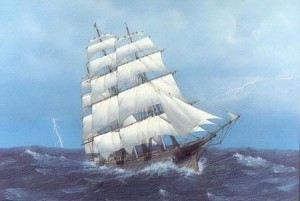For many visitors to the Great Barrier Reef, their voyage out to see the coral and wildlife is often their first experience on a sea-faring boat. Many people may be familiar with ferries or small watercraft such as a canoe or fishing dingy, but many people come to Cairns having never set foot on a large vessel. The history of boats is extensive, and the art of sailing has an especially rich history; with this history comes a lot of superstition, tradition, and lore. So, just for fun, we’ve researched five nautical superstitions that you can take with you when you board our vessel for your trip to the Great Barrier Reef.
- No Bananas on Board
At the height of the trading empire between Spain and the Caribbean in the 1700’s, most cases of disappearing ships happened to be carrying a cargo of bananas at the time. Coincidence? Perhaps. Another theory suggests that because bananas spoiled so quickly, transporters had to get to their destination much quicker. Fisherman thus never caught anything while bananas were on board. Another danger was the fruit fermenting quickly in the heat of the storage hull, where bananas would produce deadly toxic fumes. A final theory on the perils of bananas at sea (though there are tons) is that a species of deadly spider would hide inside banana bunches. Their lethal bite caused crewman to die suddenly, heightening the fear that banana cargo was a bad omen. Many boaters continue to avoid bananas at sea, some even avoiding banana smelling sun tan lotion.
- Red Sky At Night…
“Red sky at night, sailor’s delight; red sky in the morning, sailors take warning” the old saying goes. A red sunset indicates a beautiful day to come, while a red sunrise indicates rain and bad weather.
- The Pirate Look
A pierced earlobe on a sailor meant that he had sailed around the world or had crossed the equator. Superstitious sailors wore gold hoop earrings because they believed it brought good fortune. Some believed that the gold possessed magic healing powers or that it served as a protective talisman that would prevent the wearer from drowning. Tattoos were also seen as lucky. Seafarers would usually tattoo a nautical star on their bodies as the North Star represented a signal that they were nearing home. Cutting one’s hair, nail trimming, and beard shaving were seen as big no-nos.
- What’s in a Name?
It’s bad luck to change the name of the boat. Boats develop a life and mind of their own once they are named and Christened. If you do rename the boat- you absolutely must have a de-naming ceremony. This ceremony can be performed by writing the current boat name on a piece of paper, folding the paper and placing it in a wooden box then burning the box. After, scoop up the ashes and throw them into the sea.
- Don’t Kill an Albatross
Seabirds were thought to carry the souls of dead sailors and it is considered bad luck to kill one. However, it is considered good luck if you see one.
So now that you know a few myths surrounding boats and the sea, you can get ready for a great adventure on the Great Barrier Reef. So grab your earring, leave the bananas at home, and take a look at the sunrise and sunset before heading out. 
